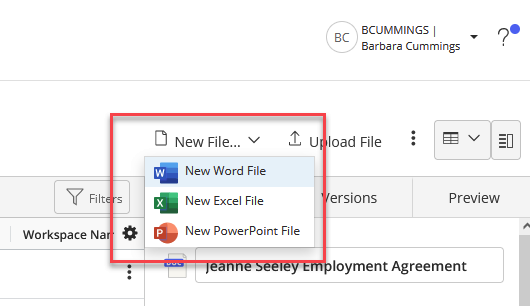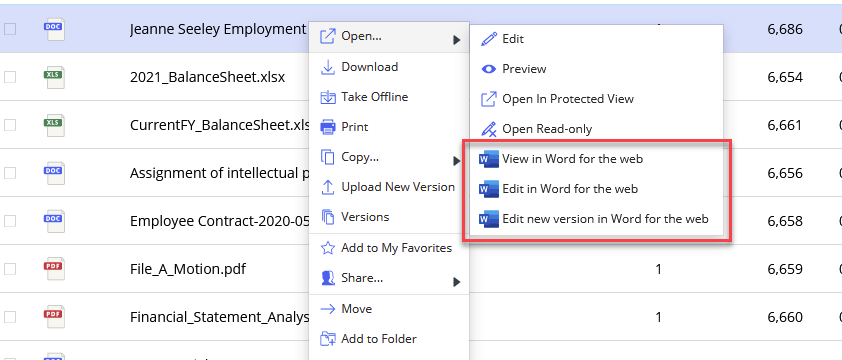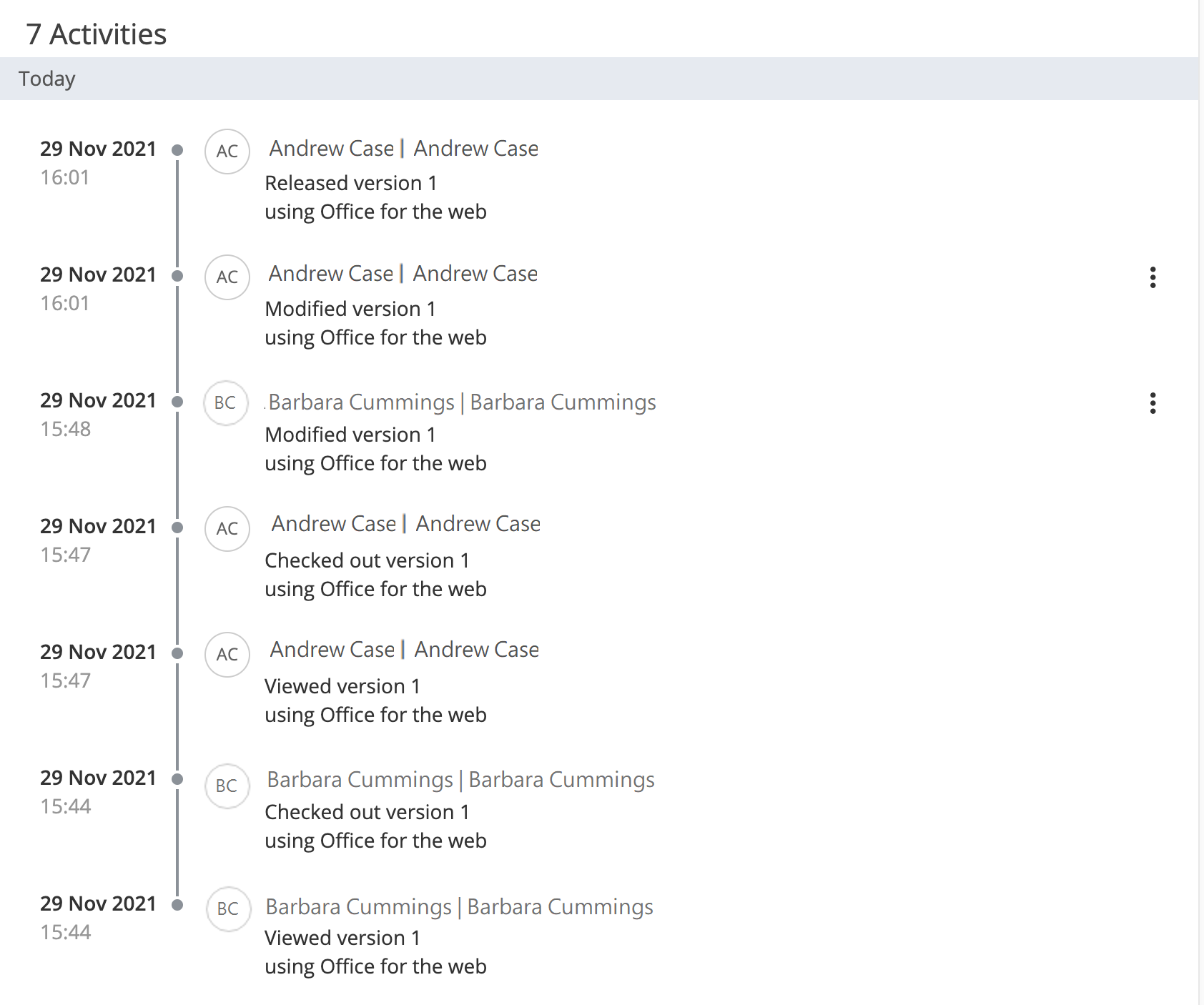Microsoft Office for the web lets users view, create, and edit Microsoft Office files without having Microsoft Office installed on their computer.
iManage Work supports full integration with Microsoft Office for the web, enabling users to access documents stored in iManage Work.
Users can use the co-authoring capabilities provided by Microsoft Office for the web. Co-authoring is the ability for multiple users to edit a file at the same time. For more information about co-authoring, refer to Co-authoring using Office Online.
NOTE: Users must have a Microsoft 365 license to view, create, edit, and co-author files using Microsoft Office for the web.
The following topics are available:
Related resources
To learn more about the capabilities available when using Microsoft Office for the web, refer to iManage Work with Microsoft Office for the web Co-authoring help.
To learn how to co-author documents when using Microsoft Office desktop applications and iManage Work desktop clients, refer to iManage Work desktop clients Co-Authoring Help.
For information about the general capabilities of iManage Work Web, refer to iManage Work Web help.
Enabling Microsoft Office for the web application in iManage Work
To integrate iManage Work with Microsoft Office for the web, you must add and enable the Office for the web application in iManage Control Center.
In iManage Control Center, browse to Settings > Applications.
Select Add Application. The Add Application dialog is displayed.
From the available list of applications, select Office for the web.
To configure OAuth details for the application, select Authentication.
Set the Allow Refresh Token switch to No.
In Access Token Expiry, configure the desired duration of inactivity allowed in minutes before invalidating an access token of a user. By default, access tokens expire after 61 minutes of inactivity.
TIP: For best results, we recommend setting the Access Token Expiry to 10 hours (600 minutes). Users with idle Office 365 editing sessions won't be forced to re-authenticate during this period.
Select Access to configure the users who can use Microsoft Office for the web. This is helpful when you have a pilot group of users, or if only specific users have a Microsoft Office 365 license.
Select one of the following access options:All users: Select this option to provide access to all the available users.
Custom: Search and add the specific users and groups to provide the access to this application. Users who aren't provided access don't see the Office for the web menu options available, and can't view, create, edit, or co-author documents in Microsoft Office for the web using their Office 365 subscription.
Select Review to review your changes.
Set Enable application? to Yes and then select Finish.
The Office for the web application is now added to the list of configured applications. Microsoft Office for the web is now integrated with iManage Work, and iManage Work users can now view, create, edit, and co-author documents in Microsoft Office for the web.
Continue with Confirming the Office for the web menus appear for iManage Work users.
Confirming that the Office for the web menus appear for iManage Work users
Users can now view the following menu options when they sign in to iManage Work.
NOTE: The menu options to View, Edit, and Edit new version are visible only for file types supported by Microsoft Office for the web. For more information, refer to Which file types are supported? in the Frequently asked questions of the iManage Work with Microsoft Office for the web Co-authoring help.
If the Microsoft Office for the web menu options don't display, users should clear the Work Web cache twice. For detailed steps, refer to Enabling Microsoft Office for the web menu options in iManage Work.
For additional troubleshooting steps, continue with Manually add the Office for the web menu options.
Manually adding the Office for the web menu options
If you have previously customized the context menus that display in iManage Work Web, you may need to take additional actions for the Microsoft Office for the web menu options to appear for users.
In iManage Control Center, browse to Work Clients > Web Client > Context Menus. The Context Menus Customization page appears.
Select Documents.
Under the Documents and Versions menus, place the cursor over Open and select .
Select Add action and select the following one at a time:
View in Office for the web
Edit in Office for the web
Edit new version in Office for the web
Select to confirm your changes.
Select Save to save your changes.
Select Folders.
Place the cursor over New and select .
Select Add action and select the following one at a time:
New Word File
New Excel File
New PowerPoint File
Select to confirm your changes.
Select Save to save your changes.
Setting Microsoft Office for the web as the default action
If you've enabled Microsoft Office for the web in your environment, you can configure iManage Work to automatically use Microsoft Office for the web whenever users view or edit a Microsoft Office document.
In iManage Control Center, browse to Work Clients > Web Client. The Settings window appears.
Select the Features tab.
In the Title-click operation for files drop-down list, select one of the following:
Preview (default): Opens the selected Microsoft Office file in preview mode.
Edit/Open: Opens the selected Microsoft Office file in desktop application if iManage Work Desktop for Windows or iManage Work Desktop for Mac is installed. However, if these applications aren't installed, the selected file opens in Microsoft Office for the web in edit mode.
Open in Protected View: Opens the selected Microsoft Office file in desktop application in Protected View if iManage Work Desktop for Windows or iManage Work Desktop for Mac is installed. However, if these applications aren't installed, the selected file opens in Microsoft Office for the web in view mode.
View in Office for the web: Opens the Microsoft Office document in view mode in Microsoft Office for the web even if iManage Work Desktop for Windows or iManage Work Desktop for Mac is installed.
Edit in Office for the web: Opens the Microsoft Office document in edit mode in Microsoft Office for the web even if iManage Work Desktop for Windows or iManage Work Desktop for Mac is installed.
The View in Office for the web and Edit in Office for the web options aren't available if you haven't enabled Microsoft Office for the application in your iManage Work environment.
If you've set View in Office for the web or Edit in Office for the web as the default, when users select a file format not supported for viewing or editing in Microsoft Office for the web, for example—.pdf file, or .txt files, then the file opens in preview mode. For more information, refer to Which file types are supported? in the Frequently asked questions of the iManage Work with Microsoft Office for the web Co-authoring help.
If users attempt to open a file they don't have sufficient access to, or a file format which can't be edited using Microsoft Office for the web, the file opens in view mode.
If you disable Microsoft Office for the web application, the default action reverts to Preview.
Frequently asked questions
Q: Does iManage Work lock a file that is being edited by a user in Microsoft Office for the web?
A: Yes, when a file is opened in Microsoft Office for the web, iManage Work locks the file to prevent users from editing the file at the same time with any other Microsoft Office desktop application.
This lock, however, doesn't apply when another user opens and edits the same document using Microsoft Office for the web. This allows Office for the web users to make full use of the co-authoring capabilities of Microsoft Office for the web.
The status of a document is updated with a globe icon to show that one or more users are actively editing the file using Microsoft Office for the web.
When a file is locked because a Microsoft Office desktop application user has opened it for editing, the status of the document is updated with a padlock icon . This file can't be opened and edited by another user until the user closes the file.
Q: A file that a user opened in Microsoft Office for the web shows the status of locked in iManage Work. Why is this, and what can I do to unlock the document?
A: When a user closes the browser tab after editing a document in Microsoft Office for the web, iManage Work automatically unlocks the document.
If the file remains locked (displaying a globe icon ), an administrator can unlock the file by performing a search for this locked document in iManage Control Center and then selecting the Unlock option. For instructions, refer to Unlocking documents.
Q: What happens if a user is editing a file in Office for the web, and their security access to this file is revoked in iManage Work?
A: While a document is opened for editing in Microsoft Office for the web, only the user(s) editing the document can modify the security of the document. All other users are prevented from modifying the security on the document until it all editing sessions are closed.
Q: What file types can be edited or viewed in Microsoft Office for the web?
A: For a list of supported file types, and the operations that can be performed, refer to Which file types are supported? in the Frequently asked questions of the iManage Work with Microsoft Office for the web Co-authoring help.
Q: Can I change the frequency with which Microsoft Office for the web saves the file while it is open?
A: When a file is opened in Microsoft Office for the web, any changes are saved automatically. There's no button or menu option for the user to manually save their changes. Users can't adjust the frequency of how often their document is saved. This auto-save frequency is predetermined by each Microsoft Office for the web application. For more details, visit the following Microsoft page: Co-authoring using Office Online.
Q: How are edits to a file captured in the document's Timeline in iManage Work?
A: When a user creates, views, or edits a file in Microsoft Office for the web, all the operations are reflected in the document's Timeline. The timeline provides information about who accessed or modified the content. It also provides information about who participated in the co-authoring sessions.
When using Microsoft Office for the web for viewing or editing Microsoft Office files, the following timeline entries are displayed:
When a file is created using Microsoft Office for the web, the timeline displayed is "Created version <#> using Office for the web" with the user details.
When a file is modified using Microsoft Office for the web, the timeline displayed is "Modified version <#> using Office for the web" with the user details.
When there are multiple users co-authoring a Microsoft file using Microsoft Office for the web, the timeline displays the name of all the users who are modifying the Microsoft file. For example, if Andrew Case and Barbara Cummings are co-authoring the Sales agreement for parties.docx simultaneously, the timeline entries are displayed as shown in the following figure.
When a new version of an existing file is created, the timeline displays "Created new version <#> using Work_Client. This version was created by selecting "Copy as new version" from Version <#>."
When the file is finally checked in, the timeline displays "Released version <#> using Office for the web" with the user details.
Figure: Timeline entries
NOTE: Timeline entries are created whenever iManage receives an update from Microsoft as a document is actively being edited. This can result in many timeline entries. Improvements are planned for a future update.




